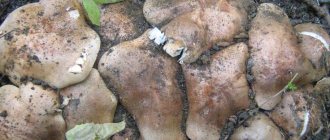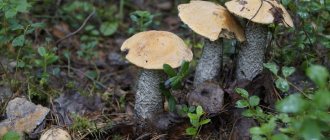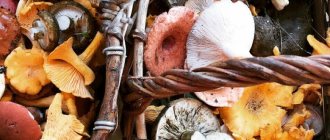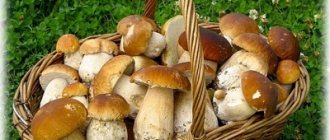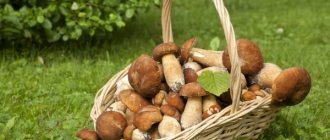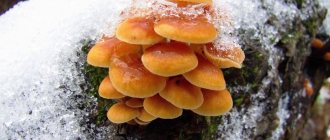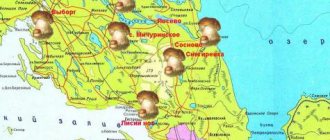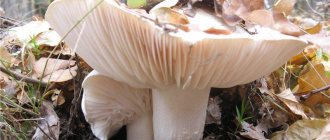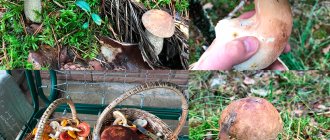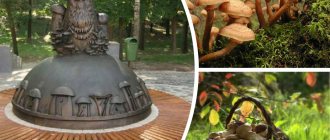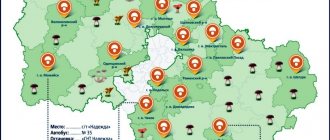Expert opinion
Gennady Sergeevich Rylov
A great expert in mycology and an avid mushroom picker. Knows everything about mushrooms, their types and places of growth
The Yaroslavl region is located at the junction of 2 natural zones: the southern strip of taiga and mixed forests, but no clearly defined division is visible. Half of the region’s territory is forested, which suggests that forest areas contain an abundance of mushrooms characteristic of both climatic zones. There are many mushroom places in the vicinity of Yaroslavl, they are visited all year round, and the trophies of quiet hunting are not only edible, but also poisonous.
Presentation of mushrooms of the Yaroslavl region
Fungal organisms combine the qualities of animal and plant life forms: plant-like bodies that are formed according to their environment. The predominant trees in forest areas are coniferous: pine, spruce, larch plantings. Broad- and small-leaved forests are less common, of which birch accounts for up to 40%. Intensive growth of mushrooms occurs in waves in 4 periods of the year:
- End of April – beginning of May. Time for morels, lines.
- June – boletus, boletus and boletus are collected throughout the month.
- Last days of July – mid-August. Lamellar ones are added to mushrooms with spongy caps: russula, milk mushrooms.
- Second half of September – October 14-17. Autumn honey mushrooms appear.
Between bursts of mushroom growth, a quiet hunt can be continued, but the prey will be much more modest. A good time to pick mushrooms is 2-4 days after rain. A later trip will upset you with a wormhole: flies and beetles lay their larvae in mushroom caps.
It is better to avoid forest areas near highways and industrial production: an important feature of any mushroom is to absorb dust, toxic gases, and heavy metals from the environment.
Flag of the Yaroslavl region.
What edible mushrooms grow today? Information by month and time of year
Despite the fact that many mushrooms growing in Yaroslavl are not suitable for consumption and are used in medicine for the preparation of medicines and dietary supplements, forest areas also contain many subspecies of edible and conventional fruits. Depending on the time of year and month, the fruiting of some replaces others, allowing mushroom pickers to collect the maximum harvest from spring to late autumn.
Spring mushrooms
The very first mushrooms to appear, like snowdrops, in plantings of aspens and deciduous trees are strings and morels. The unusual shape and ornament on the cap scare away many beginners who do not know that some subspecies of strings are edible, and morels are considered a safe and very healthy mushroom delicacy. Upon completion of their fruiting, their gradual germination begins: May row, spring and meadow honey mushrooms, boletus, and obabki.
Mushrooms growing in spring are almost never used for winter preparations. The fruits are peeled, washed, heat-treated if necessary, and prepared according to the recipe to get a tasty first or second course, delicate salad, pate, and even a snack for strong drinks.
Compared to summer, in spring there is increased humidity, which preserves fruiting and allows the mycelium to obtain as many mushrooms as possible to the delight of forest guests.
To protect your health, in addition to closed clothing, you should take a spray against insects and especially ticks when going to the forest. In the spring months they wake up and often attack people and animals.
Summer mushrooms
Despite the hot summer, usual for the Yaroslavl region, mushroom germination occurs during the period of the beginning of rains. A week after the precipitation falls, local residents can collect in their baskets: boletuses, aspen and boletus mushrooms, chanterelles and even podgruzki. When conducting a quiet hunt in pastures, you can hunt for meadow honey mushrooms, which bear fruit every year no worse than in Sverdlovsk.
If you want to collect more mushrooms, you should choose a collection location based on the germination of the rock. For example, noble species are most often found in deciduous forests. Aspen boletuses, as the name suggests, can be found in plantings of young aspens, and chanterelles can be found in tall grass.
Going on a search from the beginning of July increases the chance of finding russula and the champignon family. Beloved by many, umbrellas begin to bear fruit in hot but moderately humid weather in open areas. With luck and knowledge of the fruiting places, the harvested crop can be fried, repeating the recipe for the chops, replacing the meat with mushroom caps.
If the weather is dry in July and August, it is worth postponing mushroom fishing until better times. Until the optimal temperature for mycelium fruiting is restored in the region, time spent in search of edible prey is unlikely to bring the desired result.
Autumn mushrooms
The peak mushroom picking season in the Yaroslavl region falls in the autumn months, namely September and October. It is at this time that optimal conditions for fruiting of most types of edible and conditionally edible mushrooms are created in the region. Active germination is observed in noble families, milk mushrooms and oyster mushrooms. As an alternative for pickling, there are: Assumption, thick-legged and autumn honey mushrooms. At the time of collection, care must be taken not to confuse beneficial mushrooms with false ones.
From mid-September until the beginning of the first frosts, spruce plantings of young trees delight with the fruiting of boletus, row, hygrophora and greenfinch. And although the latter have caused concern in recent years among scientists, most experienced mushroom pickers are not afraid to pickle them after careful heat treatment.
Germination of autumn mushrooms ends only in the middle - end of November, when warm weather gives way to cold temperatures. With the onset of frost, fruiting stops, allowing the mycelium to recover until the next fruiting season.
Popular mushrooms that germinate in autumn, not included in the list above, include:
- Russula;
- saffron milk caps;
- bluelegs;
- raincoats;
- Polish mushroom.
Despite the weather conditions and the volume of the harvest, honey mushrooms are always pleasing in the fall due to the variety of edible subspecies. The controversial method of reproduction allows myceliums to stretch their borders for many kilometers, treating everyone with tasty and healthy fruits, known for their taste. You can collect honey mushrooms in 2022 in any deciduous and spruce zone. Families can be located on old trees, cleared areas, stumps, and even soil sprinkled with sawdust or leaves.
It is advisable to go to the forest a few days after precipitation falls. 5-6 days is enough for the mushrooms to grow and become ready for cutting into a basket.
Winter mushrooms
Despite the fact that frosts may be observed in the Yaroslavl region, fruiting of flammulina is possible. Winter honey fungus appears on the roots and trunks of trees when temperatures warm, reaching 0 degrees. The fruits are found throughout the winter, regardless of the week or day. If mycelium has infected a tree and the weather permits, honey mushrooms will certainly appear to the delight of local residents who know a lot about delicious mushrooms.
Repeated fruiting of noble breeds is no exception to the rule. Porcini mushrooms and oyster mushrooms often grow during the thaw, to the surprise of many mushroom pickers. The most important thing is not to miss the moment so that the returning frost does not have time to freeze the “sweet” prey.
Signs of mushroom spots
The distribution areas of fungi correspond to the comfortable living conditions of plants: they cannot be found in dense grass or thickets. Based on the state of the forest, the landscape of its growth, and the types of trees represented, it is judged whether a given area is classified as a mushroom place. Signs of favorable living conditions:
- young aspen trees along forest roads are suitable for boletuses and boletuses - they are connected to the root system of the corresponding trees;
- age of the wood: the older it is, the higher the probability of finding mycelium of honey mushrooms and oyster mushrooms under the plant;
- warm or cool - most mushrooms do not grow in cold soil, but there are also varieties that prefer cool conditions: winter honey fungus and greenfinch bear fruit in winter;
- Humidity is also perceived differently by organisms: mushrooms are predisposed to damp places, porcini mushrooms prefer dry soil;
- nutritional composition of the soil layer: champignons grow on soil enriched with organic matter, but most varieties are satisfied with the composition of ordinary forest soil.
Mushroom pickers pay attention first of all to the lowlands: abundant morning dew near water bodies maintains the moisture content of the turf layer optimal for mycelium. Places on the ground where trees rarely grow are well heated by the sun, which favors the formation of fungal clusters.
In the Yaroslavl region, mushroom pickers call the villages of Novoselka and Gorodishche as good places for porcini mushrooms. The Danilovsky district is famous for milk mushrooms, aspen mushrooms, boletus mushrooms, boletus mushrooms, and russula are widespread everywhere.
Spring mushrooms
After the melting of a thick layer of snow and the first warm rays of sunlight, the first edible mushrooms sprout on the forest soil. Strings and morels appear in clearing areas, next to young pines and on paths, where the sun warms the ground better, allowing the mycelium to grow several times better.
In the spring, mushroom pickers also collect other, no less tasty mushrooms. We are talking about such mushrooms as: puffballs, cinder omphalia, champignons, obabki and rows. Although they appear later, they are several times superior in taste and aroma to the first morels and lines.
Seasonality of “silent hunting”
The periods of appearance of mushroom varieties by season are indicated based on the results of long-term observations. Actual discrepancies with the average period can reach 1-2 months: weather conditions turn out to be more important factors in the appearance of mushrooms. The table shows the average periods of fruiting of the most famous fungal organisms in the Yaroslavl region.
| Mushrooms | March | April | May | June | July | August | September | October | November |
| Morels, lines | + | + | + | ||||||
| Champignon | + | + | |||||||
| Butter | + | + | + | + | + | ||||
| Mokhoviki | + | + | + | + | + | ||||
| Boletus | + | + | + | + | |||||
| Loadings | + | + | + | + | + | ||||
| Russula | + | + | + | + | + | ||||
| Saffron milk caps | + | + | + | ||||||
| Honey mushrooms | + | + | + | + | |||||
| Milk mushrooms | + | + | + | ||||||
| White | + | + | |||||||
| Volnushki | + | + | |||||||
| Boletus | + | + | + | + | + | ||||
| boletus | + | + | + | + | + | ||||
| Chanterelles | + | + | + |
In the region, mushrooms can also be found in winter: winter mushrooms, oyster mushrooms, and chanterelles continue to bear fruit. At the same time, toadstools do not grow in the cold season.
Who should not eat mushrooms? List of contraindications
To prevent additional health problems, it is not recommended to eat mushrooms for people who belong to the following list:
- pregnant women;
- nursing mothers until the end of lactation;
- children under 12 years of age inclusive;
- persons with chronic diseases with possible exacerbation;
- with individual intolerance to a protein product;
- during the period of exacerbation of gastritis and peptic ulcers;
- diabetes mellitus of any type.
Summary of information and recommendations
The richly diverse forests of the Yaroslavl region determine the abundance of mushroom places in the region. To become successful in any field of work, you need to work hard and improve your level of knowledge. The statement also applies to mushroom pickers. Some tips:
- morning is the best time for quiet hunting;
- before leaving for the forest, you need to inform your loved ones about the direction of the hike and the time of return;
- collect only known mushrooms, rejecting dubious and inedible ones.
Look for moist, well-warmed open forests and lowlands. Pay attention to the weather: myceliums become active within 24 hours after rain, and you can go for mushrooms after 3 days. There is no need to strive for solitude: they say, there are enough boletuses in the forest for everyone.
Mushrooms 2022, which can and should be collected
For those losing weight!
Mushrooms, rich in protein, are great for replacing many foods during dieting or a limited diet. The vitamins, micro- and macroelements contained in forest gifts are well absorbed, suppressing the feeling of hunger, despite the low calorie content. However, consuming any edible and conventional mushrooms is allowed only to people who have no contraindications to consumption. The rule applies to the following group of people: during 9 months of pregnancy, nursing mothers, children under 12 years of age, people suffering from chronic kidney, gastrointestinal and liver diseases or having diabetes of any type.
As mentioned in the article above, the first hunt is the most dangerous. To avoid the risk of poisoning and intoxication of the body, in addition to attentiveness, you should have a certain level of knowledge. If you have concerns and uncertainty about your actions at the mushroom farm, you should turn to friends or acquaintances for help, asking to take an inexperienced mushroom grower with you. However, in inevitable situations when there is no one to ask, you can use the help of fellow hobbyists who leave advice and recommendations in social networking groups. Surely someone will help initiate a newbie into the ranks of amateurs.
Despite various disputes regarding the edibility of some mushrooms, it is worth agreeing with the opinion of the poisonousness of the subspecies, so as not to harm your health. It is necessary to collect only noble and edible varieties that have many positive reviews. And it is better to refuse collecting svnushki, stitches, and greenfinches.
In the autumn season, when the peak of fruiting begins, preference is given to noble mushrooms, and only if they are not found, alternative options are collected, divided according to the degree of edibility. The first group does not require heat treatment or soaking; it is prepared immediately after washing off forest dirt. The remaining groups require additional attention, namely: single or double boiling, followed by draining the broth, soaking in salted water, removing film or trimming dirt, separating the stems from the caps, etc.
The most delicious mushrooms are rightfully considered to be: boletus, boletus and boletus, champignons and oyster mushrooms, milk mushrooms. And although everyone’s opinion on taste may change, the subspecies of these families have not lost their popularity for many years.
In the summer, when there are practically no mushrooms, and outside the window there is a drought combined with the sun, you can go to the forest for other gifts. Medicinal herbs for use as tea or folk medicine, wild berries for harvesting for the winter and beautiful flowers can always be found in a forest with rich soil.
Compared to the past year, 2022 has already begun to please mushroom pickers with rich deposits of mushrooms in the Yaroslavl region. From mid-spring to this day, lovers of quiet hunting have not ceased to gain edible usefulness. If you look at the real reviews left in the VK and Odnoklassniki groups, the germination of champignons and boletus, obabka and even meadow mushrooms is noted. And although autumn is still far away, we can make the assumption that the harvest will be better than in the previous few years. There will be enough fruit for everyone not only for food, but also for preparing food for the winter.
Edible species by season
Many types of Yaroslavl mushrooms are used to make medicines, but they are mainly used in cooking depending on the season in which they bear fruit. Local residents collect mushrooms from early spring to late autumn.
Spring
The very first to appear on old leaves are morels and lines with unusual caps. Morels often grow near paths, closer to clearings, while lines grow in pine forests on sandstone. They are found near old stumps, where spring warmth is well preserved.
Irina Selyutina (Biologist):
The morel cap belongs to the family Morscheollaceae (Morelaceae) and is a representative of the genus Verpa, or Cap. The mushroom got its name due to its resemblance to real morels, as well as the way the cap is located on the stem. The cap is found on the territory of the Yaroslavl region only in the Pereslavl and Rostov regions. Its leg is smooth, curved, often flattened on the sides, and can reach a length of 6-10 cm and a thickness of 1.5-2.5 cm. Its color is cream or white. The surface is covered with small scales of the same color as the leg itself. In young specimens the stalk is solid, but as the mushroom grows it becomes hollow. The cap is bell-shaped, vertically folded. Its color changes as the fungus grows. In young specimens it is almost chocolate-colored, but in mature specimens it is ocher-yellow. It is located freely on the leg, connecting to it only at the base (at the top point). The height of the cap is about 2-5 cm, and the diameter is about 2-4 cm. The pulp is waxy in appearance. Like morels, morel caps can be boiled and fried.
Poisonous varieties
In the Yaroslavl region there are also inedible mushrooms that are dangerous to the human body.
Be careful not to encounter such a representative.
Fly agarics
Poisonous mushrooms should not be eaten
It is difficult to confuse fly agaric with other varieties. Every child knows the features of the appearance of this mushroom.
It can be recognized by its large red cap, covered with white spots - remnants of the blanket, which can be washed off during heavy rain. The leg is thin, white with a clearly visible “skirt”. If you touch a fly agaric, it will immediately emit an unpleasant aroma.
They first appear in early April, with the arrival of warmth. They are found in forests, next to rotten trees.
Some chefs have learned how to properly prepare this type of dangerous mushroom, but for the average person it can be fatal.
Death cap
The external characteristics of this variety are reminiscent of forest champignons. The white cap and leg darken if the body is broken. The average height of individual specimens reaches 10-12 cm. The old mushroom has a sweetish taste.
The pale grebe is found both in forests and meadows. Try not to take risks and avoid questionable mushroom bushes.
Pravda station
You can pick mushrooms on both sides of the railway, 1-2 kilometers away. To the west - towards the village of Stepankovo, to the east - to the village of Nazarovo.
Considering the territorial location of the region, you need to be very careful, since false mushrooms grow in the south, which are poisonous in greater quantities than in the northern part of the country. Collecting forest delicacies is a very exciting activity, but it is better if an experienced person in this matter helps you for the first steps in the “quiet hunt”.
Precautionary measures
Despite the benefits of mushrooms, some varieties pose a danger to life. To avoid poisoning or death, you need to follow basic safety precautions.
- Do not take copies that cause you doubts. Edible ones often have poisonous counterparts. If you notice any oddities in the appearance of the mushroom, do not put it in the basket.
- Go hunting in the morning, preferably at 6-7 o’clock, when the sun is not yet burning hard and the mushrooms are not warm.
- The harvested crop is prepared on the same day.
- Do not pick mushrooms near industrial facilities. All toxic substances released by the enterprise settle on the surface of the fruiting bodies, which are then consumed by people.
- Before cooking, the collected specimens must be soaked to remove toxins and dirt. Do not use galvanized basins for washing.
Cut the mushroom or twist it out of the soil - you decide for yourself. It is only important to clean the stem from dirt before putting the mushroom in the basket.
When going on a “silent hunt”, a mushroom picker must take with him a special reference book.
There are many regions in Russia with large forests where rich mushroom harvests are harvested, and one of them is the Yaroslavl region. Mushrooms of the Yaroslavl region in 2022 began to appear in January due to natural anomalies.
Mushrooms of the Yaroslavl region in 2022
Sokoloskaya station
You can get from the Shchelkovskaya metro station by bus No. 349 to the final stop Shchelkovo-7. Then you can catch a passing car and go in a southwestern direction. After driving a little, you need to get out and move in the same direction along the forest. This route can also be taken from Yaroslavsky railway station. Take the train to the village of Monino or Fryazevo to Sokoloskaya. The journey will take 40 minutes. Then take a minibus or bus to the village of Krasnoznamensky, then walk 2 kilometers north to the Klyazma River.
general characteristics
Mushrooms can complement the diet and saturate the body with useful microelements and vitamins.
According to the degree of edibility they are divided into several categories:
- Category 1: edible;
- Category 2: conditionally edible;
- Category 3: inedible;
- Category 4: poisonous.
In addition to dividing mushrooms into categories according to edibility, since the times of the USSR in cooking, dividing mushrooms into categories according to taste characteristics has been used:
1st taste category: the most nutritious and delicious mushrooms are included here. For example, russula and champignons are often consumed without heat treatment. White mushrooms and milk mushrooms are also good in any form - they are aromatic, easy to clean and prepare.
Taste category 2: it is represented by good edible mushrooms, which are quite a bit inferior to representatives of the 1st category in quality and taste. This includes Polish, boletus and saffron milk caps. They make side dishes, main courses and aperitifs.
Taste category 3: mushrooms are characterized by average taste, they are collected only if nothing else can be found. Flywheels, honey mushrooms and morels have an average aroma and taste. They make pates from them and add them to hot salads.
4th taste category: these are conditionally edible mushrooms of low quality. They need pre-soaking and cooking; they take a long time to cook. In pickles, aromatic spices are used to enhance the taste.
However, now the division into these strict food categories is gradually abandoned and the nutritional value for each mushroom is indicated. Therefore, the same mushroom can be “listed” in completely different categories. A striking example of such “food vagabondage” can be considered champignon, which previously belonged to the 3rd category, and now to the 2nd or even 1st, which is determined by its popularity in cooking.

